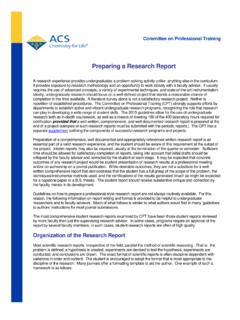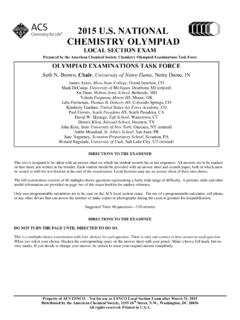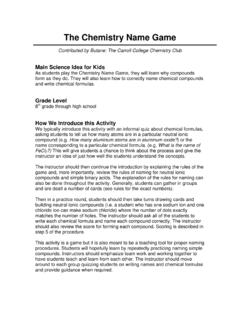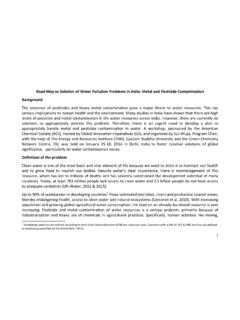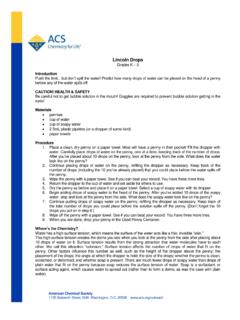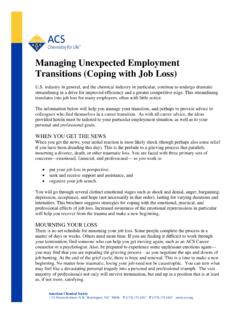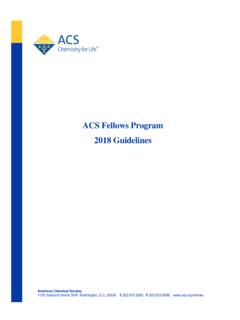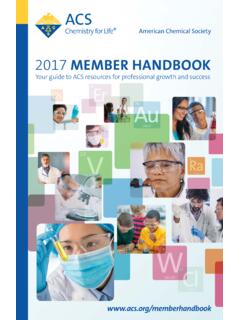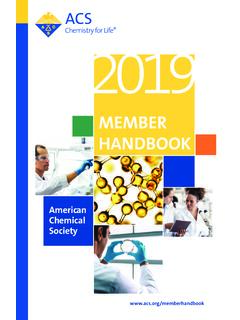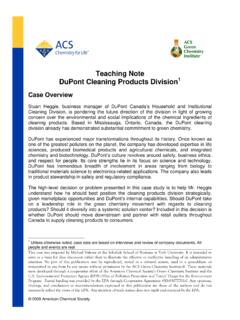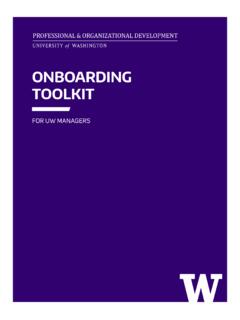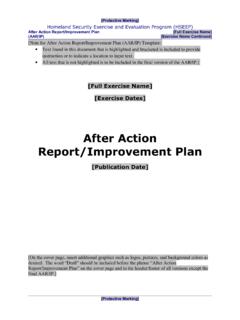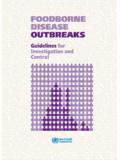Transcription of Identifying and Evaluating Hazards in Research Laboratories
1 Identifying and Evaluating Hazards in Research Laboratories Gui delines developed by the Hazar d I dentif ication and E valuation Task For ce of the American Chemical Society s Committe e on Chemi cal safety Copyright 2015 American Chemical Society 2 TABLE OF CONTENTS FOREWORD .. 5 ACKNOWLEDGEMENTS .. 7 TASK FORCE 8 EXECUTIVE SUMMARY .. 9 1. SCOPE AND APPLICATION .. 11 Scope .. 11 Application .. 11 2. DEFINITIONS .. 11 3. HAZARD IDENTIFICATION AND EVALUATION .. 17 Introduction to Hazard Identification and Evaluation .. 17 Key Elements of Hazard Identification and 18 4. ESTABLISHING ROLES AND RESPONSIBILITIES .. 22 Institutional and Departmental Administration.
2 22 Principal Investigator .. 22 Researcher and Laboratory Worker .. 24 Support Personnel .. 24 5. CHOOSING AND USING A TECHNIQUE FROM THIS GUIDE .. 25 Desired Attributes of a Hazard Identification and Evaluation Tool or System .. 25 Quick Start Introduction .. 25 Choosing the Method Best Suited for the Research .. 25 Suggestions for Implementing Hazard Identification and Evaluation Processes Indifferent to Technique Chosen .. 26 6. CHANGE CONTROL .. 27 Recognizing Change .. 27 Factors that Affect Recognition of Change .. 28 Strategies for Enabling Recognition of and Responding to Change .. 28 7. ASSESSING IMPLEMENTATION .. 29 8. CONTROL BANDING CHEMICAL USES IN Research 31 Introduction.
3 31 Quick Start: Control Banding .. 31 Under What Scenarios Might One Consider Using the Method? .. 32 Pros, Cons, and Limitations .. 32 Suggested Approach to Establishing Chemical safety Levels .. 33 Using Raw Data to Estimate a Chemical safety Level .. 36 3 Reminder .. 37 9. JOB HAZARD ANALYSIS .. 39 Introduction .. 39 Quick Start: Job Hazard Analysis .. 39 Under What Scenarios Might One Consider Using the Method? .. 39 Pros, Cons, and Limitations .. 41 Job Hazard Analysis Instructions and Template .. 41 Keys to Success in Using the Method .. 44 How to Assess Effective Job Hazard Analysis Use .. 45 10. WHAT-IF ANALYSIS .. 47 Introduction.
4 47 Quick Start: What-If Analysis .. 47 Under What Scenarios Might One Consider Using the Method? .. 48 Limitations .. 48 Keys to Success .. 49 Hazard Operability Analyses .. 55 Completing the What-If Analysis .. 57 Examples of What-If Analyses .. 57 No Single Format or Approach to What-If and HazOp .. 61 Using What-If Thinking Independently and in 61 Measures of Success with this Approach .. 63 Realizing Limitations and Seeking Assistance .. 64 11. CHECKLISTS .. 65 Introduction .. 65 Quick Start: Checklists .. 65 Applicability and Uses for Checklists .. 66 Benefits and Limitations of Checklists .. 69 Hazard Analysis Checklists .. 70 Exposure Control Methods.
5 71 Assessing the Effective Use of Checklists .. 71 Keys to Successful Implementation and Use of Checklists .. 73 Traditional Laboratory safety Checklist .. 74 Laboratory Hazard Risk Assessment Matrix .. 75 Laboratory Process Risk Assessment Matrix .. 76 Laboratory Process Risk Assessment Checklist for a Process Using a Chemical .. 77 Chemical Hazard Assessment Tool for High Hazard Chemicals .. 78 12. STRUCTURED DEVELOPMENT OF STANDARD OPERATING PROCEDURES .. 81 Introduction .. 81 Quick Start: SOPs .. 81 Under What Scenarios Might One Consider Using the Method? .. 82 4 Pros, Cons, and Limitations .. 82 Using the template .. 82 Keys to Success .. 83 Sample Scenario.
6 86 Assessing the Effective Use of this Assessment 89 How to Incorporate this Tool into Daily Activities .. 89 13. REFERENCES .. 90 APPENDIX A: GLOSSARY OF ACRONYMS .. 92 APPENDIX B: RISK RATING .. 93 APPENDIX C: SUPPORTING INFORMATION FOR CHEMICAL safety 98 APPENDIX D: SUPPORTING INFORMATION FOR CONDUCTING JOB HAZARD ANALYSIS .. 99 APPENDIX E: SUPPORTING INFORMATION FOR CONDUCTING WHAT-IF ANALYSIS .. 105 APPENDIX F: SUPPORTING INFORMATION FOR USE OF CHECKLISTS .. 109 APPENDIX G: SUPPORTING INFORMATION FOR STRUCTURED DEVELOPMENT OF SOPS .. 138 5 FOREWORD Before 2008 the Chemical safety and Hazard Investigation Board, also known as the Chemical safety Board (CSB),a was concerned about reports of significant incidents in academic Laboratories .
7 The CSB indicated this concern would likely lead to an investigation of a future serious incident in an academic laboratory. In January 2010, a chemistry graduate student at Texas Tech University was seriously injured in an explosion. The CSB investigated this incident and issued its report in October 2011. The CSB noted: The lessons learned from the incident provide all academic communities with an important opportunity to compare their own policies and practices to that which existed at Texas Tech leading up to the incident. The CSB report noted several factors contributed to the incident, including Comprehensive guidance on managing the Hazards unique to laboratory chemical Research in the academic environment is lacking.
8 Current standards on hazard evaluations, risk assessments, and hazard mitigation are geared toward industrial settings and are not transferrable to the academic Research laboratory environment. 1 The CSB asked the American Chemical Society (ACS) for assistance with developing guidance that would address this information gap. The ACS accepted the CSB recommendation to: Develop good practice guidance that identifies and describes methodologies to assess and control Hazards that can be used successfully in a Research laboratory. The ACS assigned the responsibility for this task to the ACS Committee on Chemical safety (CCS). The CCS, in close coordination with the Division of Chemical Health and safety , commissioned a task force of stakeholders and subject matter experts to create a guide for Identifying and Evaluating Hazards , and managing the associated risks of these Hazards in Research Laboratories .
9 The following factors were considered during the development of this guide: To provide techniques to ensure hazard information is gathered and analyzed; To aid researchers in recognizing the value of input from others with varying experiences; To provide techniques that can be used for a variety of different types of activities (routine protocols, modifications to current Research , or entirely new activities); and To consider the variable nature of Research tasks by providing tools that help researchers recognize and respond to change both large and small. This guide was developed for researchers without deference to where they are in their careers undergraduate students, graduate students, postdoctoral scholars, instructors, principal investigators (PIs), technicians, or department chairs who have varied approaches to learning and experimental design and who may require different kinds of assessment tools.
10 A See APPENDIX A for a glossary of acronyms. 6 ACS seeks to develop tools that are useful for colleagues working in the scientific Research community. It is important that strong communication and the exchange of ideas between ACS and the Research community be established and maintained, so we can clearly learn what does and does not work well. This will allow ACS to modify these techniques to be more useful. It is the sincere hope of ACS that hazard identification and evaluation techniques become incorporated into the everyday activities of the scientific Research community. 7 ACKNOWLEDGEMENTS The ACS Committee on Chemical safety acknowledges the following: The members of CSB, for their continued dedication to providing sound investigations of chemical-related accidents across the United States which, in turn, enable us to develop better ways to protect ourselves and our colleagues.
